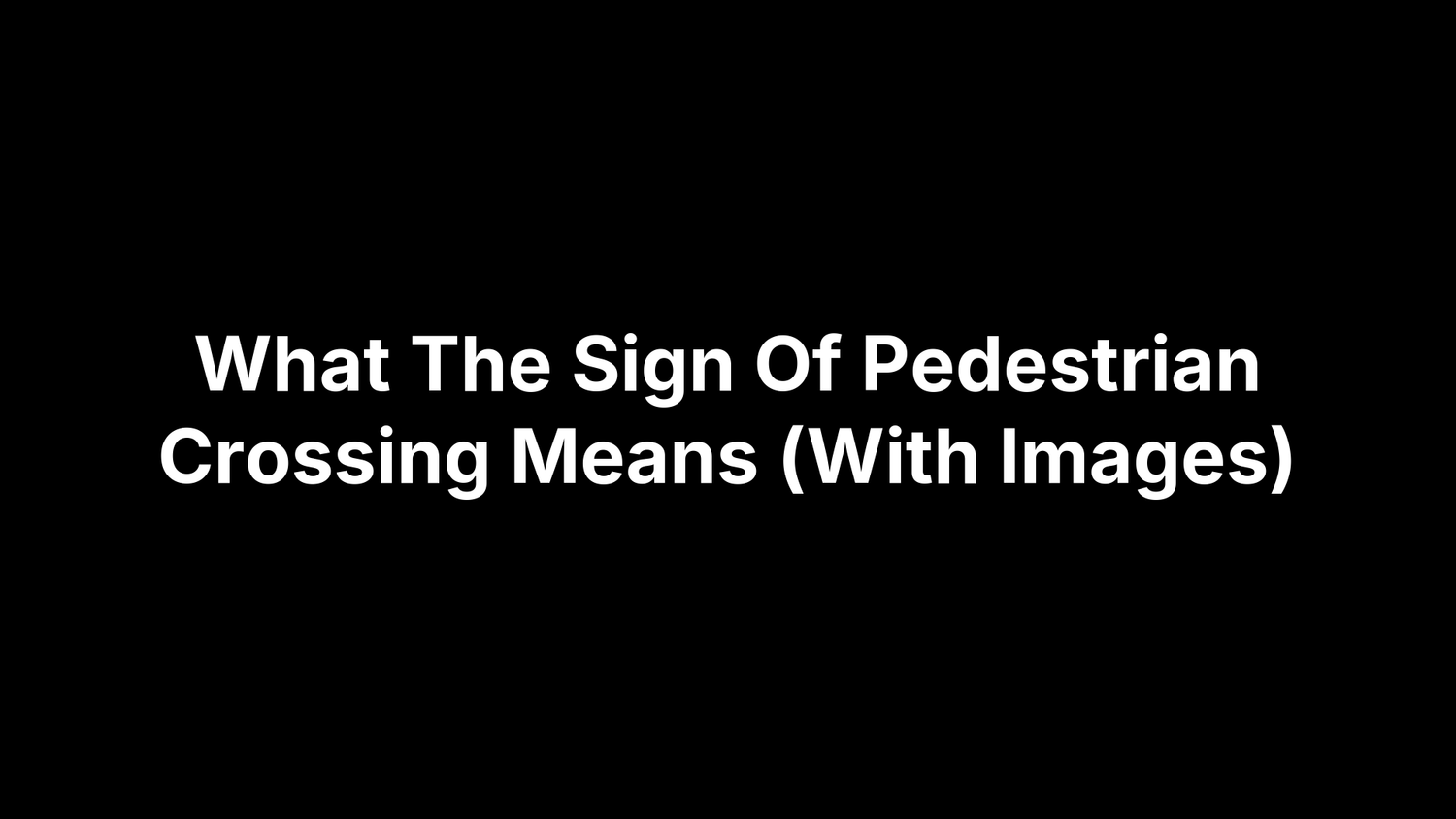What The Sign Of Pedestrian Crossing Means (With Images)
The “sign of pedestrian” most people ask about is the pedestrian crossing sign: a yellow diamond featuring a black walking person symbol. Its job is simple and critical—warn drivers to slow down and yield to people in or approaching a crosswalk. You’ll also see it paired with a downward arrow plaque pointing to the exact crossing. In school areas, a similar purpose is served by the fluorescent yellow‑green pentagon showing two walking figures. Together with crosswalk lines and, in some locations, pedestrian signals, these signs help drivers and pedestrians understand where and when crossing is safest.
In this guide, you’ll see exactly what the pedestrian crossing sign looks like (with clear images), what it means for both drivers and pedestrians, and where it’s typically installed. We’ll cover common variations and how to tell it apart from school crossing signs, how signs differ from pedestrian signals, what pavement markings to expect, and how enhanced beacons like RRFBs and HAWK signals work. You’ll also get right‑of‑way rules, common mistakes to avoid, the key standards that govern these signs, plus practical buying and placement tips—along with downloadable templates.
What the pedestrian crossing sign looks like (the “sign of pedestrian”)
The U.S. “sign of pedestrian” is the pedestrian crossing warning sign: a yellow diamond with a black walking‑person symbol, designated MUTCD W11‑2. It’s typically placed in advance of a crosswalk, and is often paired with a downward‑pointing arrow plaque (W16‑7P) mounted below to mark the exact crossing. In school areas, a related fluorescent yellow‑green pentagon shows two walking figures. Some locations also use an in‑street version on a flexible post (R1‑6) at the centerline.
What the sign means for drivers and pedestrians
When you see the pedestrian crossing sign (the “sign of pedestrian”), treat it as an advance warning that people may be entering the roadway. Slow to a safe speed, scan both sides, and be prepared to yield. If a downward arrow plaque is mounted below, the crosswalk is exactly at that point. In general, pedestrians have the right‑of‑way in crosswalks, but at signalized crossings they must obey pedestrian signals: start on WALK, don’t start on a flashing hand, and if it begins flashing after you’ve started, continue to the other side.
- For drivers: Slow, yield to people in or entering the crosswalk, and do not overtake vehicles stopped at a crossing.
- For pedestrians: Cross within the marked area, make eye contact, and follow WALK/DON’T WALK indications where present.
Where you’ll see it and common variations
You’ll see the pedestrian crossing sign on approaches to crosswalks at intersections and midblock locations with heavy foot traffic—especially in school zones and residential areas. Agencies use a few common variations to fine‑tune visibility and driver behavior for this “sign of pedestrian.”
- Downward arrow (W16‑7P): Points to the exact crosswalk location.
- In‑street centerline sign (R1‑6): Flexible post at uncontrolled crossings reminding drivers to stop/yield to pedestrians in the crosswalk.
- School crossing version: Bright yellow pentagon with two walking figures for school zones.
Pedestrian crossing vs school crossing: how to tell them apart
Both warn you to expect people on foot, but they’re easy to distinguish at a glance. The everyday pedestrian crossing sign—the “sign of pedestrian”—is a yellow diamond with a single walking person. The school crossing sign is a brighter, fluorescent yellow‑green pentagon showing two walking figures, used near schools to highlight child pedestrians and higher activity during arrival and dismissal times.
- Pedestrian crossing: Yellow diamond, single walker, general locations.
- School crossing: Fluorescent yellow‑green pentagon, two walkers, near schools; slow early and watch for crossing guards and buses.
Pedestrian signs vs pedestrian signals: what each one tells you
Think of the pedestrian crossing sign as a location warning; the pedestrian signal tells you when to go. The “sign of pedestrian” (W11‑2) is static and alerts drivers to yield near a crosswalk. The signal is dynamic, assigning right‑of‑way to people and vehicles.
- Pedestrian signs: Warn and locate crossings. Drivers slow and yield; pedestrians don’t have automatic permission—check traffic and any signal.
- Pedestrian signals: WALK/white person = start. Flashing raised hand/orange = don’t start; finish if already crossing. Steady raised hand = don’t go. Many sites require pushing the button; where no pedestrian signals exist, obey the red/yellow/green traffic lights.
Crosswalk markings and pavement clues that pair with the sign
When you see the pedestrian crossing sign—the “sign of pedestrian”—look for pavement cues that pinpoint the crossing itself. The most common marking in the U.S. is the high‑visibility zebra pattern: broad white bars that span the lane. Crosswalks can also legally exist at intersections even when unmarked, as a continuation of the sidewalks. At midblock or other uncontrolled locations, agencies may add in‑street devices to further alert drivers and reinforce yielding behavior.
- Zebra stripes: High‑contrast white bars used with or without traffic signals to delineate the crosswalk.
- Unmarked intersection crosswalks: The sidewalk‑to‑sidewalk path across the roadway may be a legal crossing even without paint.
- Downward arrow plaque (W16‑7P): Mounted under the sign to point to the exact crosswalk location.
- In‑street centerline sign (R1‑6): Flexible post reminding drivers to stop/yield to pedestrians in the crosswalk as state law requires.
Enhanced crossings and beacons (RRFB, HAWK) explained
Some crossings need more than a sign and paint. To boost visibility and driver yielding, agencies add beacons. Two you’ll see often are RRFBs and HAWK (pedestrian hybrid) beacons. Both pair with the W11‑2 sign and crosswalk markings to spotlight people entering the roadway.
-
RRFB (Rectangular Rapid‑Flashing Beacon): Amber LEDs flash rapidly when a pedestrian pushes the button. It doesn’t display red; it intensifies the warning so drivers slow and yield to people in the crosswalk.
-
HAWK/PHB (Pedestrian Hybrid Beacon): Dark until activated, then shows yellow and a red phase. Drivers stop on solid red; on flashing red, stop, then proceed when the crosswalk is clear.
Right-of-way rules and safe driving behaviors at crossings
Right-of-way at crossings is simple: the pedestrian crossing sign (the “sign of pedestrian”) warns that people may be in the roadway, and state laws require drivers to yield—or stop, as applicable—for pedestrians in marked crosswalks and for those already crossing at unmarked intersection crosswalks. At locations with pedestrian signals, people start on WALK; drivers, especially when turning, must yield. Where no signals are present, treat the sign and crosswalk markings as an immediate cue to slow and be prepared to stop.
- Yield/stop for people in or entering the crosswalk: Give them space to finish safely.
- Never pass a vehicle stopped at a crosswalk: Someone may be crossing ahead.
- Don’t block the crosswalk: Stop before the lines so pedestrians can pass.
- Scan, slow, and cover the brake: Expect someone from either side, especially near parked cars.
- Honor beacons and signals: Solid red means stop; on flashing red (HAWK), stop, then go when clear.
- Let late starters finish: If the hand begins flashing after entry, pedestrians may continue—allow them to cross.
Common mistakes to avoid around crosswalks
Even careful drivers and pedestrians make small errors that create big risks. When you see the sign of pedestrian and related markings or signals, avoid these common mistakes to keep crossings predictable and safe.
- Failing to yield/stop for people in or entering the crosswalk.
- Passing a stopped vehicle at a crosswalk—someone may be crossing.
- Blocking the crosswalk while waiting at a light or to turn.
- Ignoring beacons/signals (roll-throughs on HAWK flashing red are illegal without a full stop).
- Turning on green without yielding to pedestrians in the crosswalk.
- Starting to walk on a flashing or steady raised hand signal.
Standards and codes you should know (MUTCD W11-2, W16-7P, R1-6)
In the U.S., the Manual on Uniform Traffic Control Devices (MUTCD) standardizes pedestrian signs. For the “sign of pedestrian,” know three codes: W11‑2 (the symbol sign), W16‑7P (the downward arrow pointing to the crosswalk), and R1‑6 (the in‑street regulatory sign at uncontrolled crossings reminding drivers to stop or yield for people in the crosswalk).
- W11‑2: Pedestrian Crossing warning—yellow diamond with a walking person.
- W16‑7P: Downward arrow plaque mounted below W11‑2 to mark the crossing.
- R1‑6: In‑street centerline sign reminding motorists to stop/yield in the crosswalk.
Buying guide: sizes, materials, and reflectivity for compliance
Selecting a compliant “sign of pedestrian” comes down to visibility, durability, and the right code pairings. Use the W11‑2 symbol (add the W16‑7P arrow to pinpoint the crosswalk), choose yellow for general crossings and fluorescent yellow‑green in school zones, and specify retroreflective faces so drivers see the sign at night and in rain.
- Size: Follow your agency/MUTCD guidance; use larger panels on higher‑speed or higher‑volume roads.
- Reflectivity: Choose prismatic retroreflective sheeting (e.g., ORALITE) for long‑range night visibility.
- Material: Rigid, corrosion‑resistant panels with UV‑stable inks/laminate for outdoor longevity.
- Mounting: Pre‑punched holes for posts; where allowed, pair with in‑street R1‑6 devices at uncontrolled crossings.
Placement and installation basics for clear visibility
Place the W11‑2 pedestrian crossing sign where drivers can recognize it early enough to slow or stop, then use the W16‑7P downward arrow directly at the crosswalk to pinpoint the location. Keep signs clear of visual clutter and obstructions, align with the crosswalk, and install on both approaches of two‑way roads. Maintain retroreflectivity, trim vegetation routinely, and where allowed, pair an in‑street R1‑6 at uncontrolled crossings for extra reinforcement.
- Advance placement: Warn first, then locate with the arrow at the crossing.
- Clear sight lines: Keep free of trees, poles, and parked vehicles.
- Consistency: Match orientation and spacing used for other warning signs nearby.
Pedestrian crossing sign images and downloadable templates
Use clear, high‑res images of the “sign of pedestrian” (W11‑2 yellow diamond with a walking person), the W16‑7P downward arrow that pinpoints the crosswalk, the school pentagon variant, and in‑street R1‑6 panels. For scaling or print, choose vector templates (SVG/PDF) so symbols stay sharp and MUTCD proportions remain correct across sizes.
Related signs you may need for a complete system
A complete crossing rarely relies on a single panel. Pair the W11‑2 pedestrian symbol with complementary signs that pinpoint the crosswalk and reinforce driver duty; add higher‑visibility devices where speed, volumes, or sightlines demand it.
- Downward arrow plaque (W16‑7P): Pinpoints the exact crossing.
- In‑street centerline sign (R1‑6): Reminds drivers to stop/yield.
- School crossing pentagon: Two walking figures for school zones.
Key takeaways
The pedestrian crossing sign—the yellow diamond with a walking person—alerts drivers to slow, scan, and be ready to yield at a crosswalk. The downward arrow plaque pinpoints the exact location, while the school pentagon warns of child pedestrians near schools. Signals assign when to go; markings and beacons reinforce where and how to cross safely.
- Recognize it: W11‑2 yellow diamond (walker); W16‑7P arrow marks the crossing; school version is a fluorescent pentagon with two figures.
- Drivers: Slow, yield/stop for people in or entering the crosswalk; never pass a car stopped at one; don’t block the lines.
- Pedestrians: Start on WALK; finish if the hand starts flashing after you’ve begun.
- Context clues: Zebra stripes mark many crosswalks; some intersection crosswalks exist legally even unmarked.
- Upgrades: RRFBs boost yielding; HAWK beacons display red—stop, then proceed when clear on flashing red.
Need compliant pedestrian crossing signs or custom plaques? Order direct from our team at Safety Decals.


